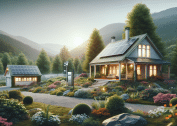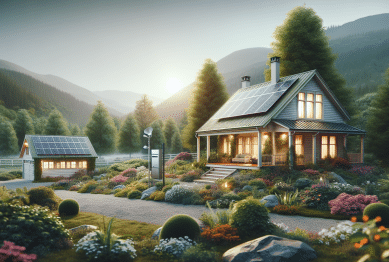Discover how practical smart home upgrades can transform daily living with added comfort and convenience. This guide explores accessible solutions, real cost factors, and energy-saving ideas to help streamline your home and garden routines in ways most people don’t expect.
Why Smart Home Upgrades Matter for Everyday Living
Smart home upgrades are no longer reserved for futuristic concept houses or tech enthusiasts. Today, these innovations make routine tasks simpler and home environments friendlier to both residents and guests. Features like automated lighting, voice-controlled thermostats, and smart irrigation systems are designed with user-friendliness as a priority. The allure of these home and garden advances lies in their seamless integration into everyday life. Instead of chasing trends, many homeowners now prioritize reliability, security, and ease of control when adding technology at home. These benefits become even more pronounced when selecting devices that truly support daily routine, from controlling the lights while lounging on the sofa to receiving alerts about water usage in the garden.
Real-world convenience is at the heart of most popular smart upgrades. Devices like programmable thermostats can learn your schedule and adjust accordingly, minimizing energy use while keeping spaces comfortable. Many solutions, such as smart door locks and security cameras, also enhance safety without complicating your lifestyle. The option to control major household functions remotely – using a smartphone, tablet, or voice assistant – helps create a sense of control and peace of mind. In gardens, weather-sensing irrigation controllers have made it easier for homeowners to nurture plants efficiently while avoiding waste.
Perhaps the most meaningful aspect of easy smart home upgrades is their tangible improvement to everyday routines. Mundane chores become streamlined and sometimes even enjoyable. Imagine waking up to lights that ease on softly, coffee starting automatically, and outdoor spaces watered only when needed. These systems don’t just address modern convenience – they boost sustainability and adapt to life changes. Over time, such upgrades often reward users not just in saved effort, but in utility cost reductions and added property value too.
Affordable Entry Points for Smart Home and Garden Integration
Cost often emerges as a deciding factor for homeowners and renters considering smart technology. Luckily, the market now offers a wide variety of affordable entry points to explore. Plug-and-play options such as smart plugs, sensors, and bulbs mean you don’t have to overhaul wiring or purchase expensive kits. These devices typically connect through Wi-Fi or Bluetooth, enabling instant control and monitoring with just a mobile app. The flexibility to start small while expanding over time caters to those with tight budgets or shifting needs.
Entry-level systems, like starter smart lighting kits or basic outdoor weather sensors, introduce energy management with minimal setup. Such upgrades not only manage power more efficiently but gather useful data about usage patterns that can inform future changes. Affordable smart sprinklers and irrigation controllers are especially valuable for home gardens, cutting down water use and preventing overwatering. Many homeowners find these investments quickly pay off just through energy and water bill reductions.
Accessible technology has removed much of the intimidation barrier associated with smart home systems. DIY-friendly products come with guided installations and dedicated support, lowering risks and frustration. Some insurance providers even offer discounts for qualifying smart security devices once installed, further improving cost efficiency. With so many mainstream brands producing compatible devices, good-quality upgrades are no longer exclusive or out of reach. Selecting the right options based on actual needs ensures users get technology they’ll consistently use, not just admire.
Optimizing Energy Efficiency with Smart Controls
One of the immediate draws of a smart home is the promise of greater energy efficiency. By leveraging automated controls and remote access, residents can easily cut waste and reduce utility expenses. Smart thermostats are standout performers, dynamically adjusting settings based on occupancy and weather patterns to minimize excess use. In garden areas, modern irrigation control systems use real-time weather data to avoid watering before, during, or after rainfall, protecting both water resources and plant health.
Lighting is another major area of improvement. Smart LED bulbs, dimmers, and motion-activated switches can be scheduled for optimal times and adjusted for precise needs. Not only does this reduce unnecessary consumption, but it also extends bulb lifespan and lowers replacement costs. For even greater efficiency, energy monitoring systems provide clear, device-level insights, helping identify which appliances contribute most to monthly bills. Awareness is the first step towards smart reduction of those energy drains.
Long-term savings and sustainability stem from combining several upgrades throughout the home and garden. Systems that communicate with each other – for example, a smart thermostat that interacts with window sensors or a sprinkler controller aware of upcoming rain – can adapt to subtle changes in environment. This level of coordination ensures less waste and a more balanced ecosystem indoors and out. Over time, users often notice lighter bills and a smaller environmental footprint, without sacrificing comfort or convenience.
Boosting Home Security With Reliable Smart Solutions
Security remains a primary concern for many homeowners and renters, and modern smart upgrades now address it more comprehensively than legacy systems. Options like video doorbells provide two-way communication with visitors, motion-detecting alerts, and even cloud storage for recorded footage. Smart locks can be programmed with temporary codes for guests, eliminating the need for physical keys or constant supervision. These improvements reduce anxiety and increase flexibility in home access management.
Homeowners appreciate the ability to monitor their property from anywhere. Security cameras deliver real-time surveillance that is accessible via smartphones, with instant notifications if suspicious activity is detected. Garden cameras with night vision help keep outdoor spaces secure without major infrastructure changes. Integration with other systems, like lighting or alarms, means a single trigger (such as motion after dark) can initiate multiple responses, from turning on lights to alerting authorities, all managed discreetly.
Smart security tech has also empowered caring for vulnerable family members or treasured pets. From indoor air quality monitors to door and window sensors, residents can be notified of abnormal circumstances right away. These systems foster peace of mind during travel or busy periods at work, ensuring no event goes unnoticed. For households focused on safety for all ages, accessible solutions offer meaningful safeguards without intrusive behavior or high costs.
Creating Comfort and Convenience for Every Lifestyle
Comfort is often what people seek most at home, and smart upgrades cater to this core need. Automated climate control ensures perfect temperatures year-round, responding not just to the weather outside but the actual usage of spaces throughout the day. Voice assistants can orchestrate entire routines, cueing music, lights, and climate precisely when wanted. For those tending gardens or busy with family, these features mean one less thing to manage or remember.
Convenience extends to routine organization too. Smart speakers manage calendars, reminders, shopping lists, and even recipes with simple voice commands. The synergy between indoor and outdoor tech makes it easier to coordinate daily activities, watering plants just before guests arrive or prepping garden lights for an evening gathering. For aging adults or people with mobility challenges, these upgrades often enhance independence without demanding complex interfaces or physical effort.
Personalization is a key trend in smart home comfort. Settings and scenes can be fine-tuned for different family members or occasions: evening relaxation, working from home, or social events. Integration with entertainment systems creates immersive experiences, from synchronized lighting in the living room to outdoor speakers in the garden. Over time, even modest investments deliver transformative value in quality of life – a process that’s easy to start, expand, and evolve as future needs arise.
What to Consider Before Adding Smart Upgrades
Every successful smart home journey begins with clear priorities and some basic planning. Compatibility matters: it’s essential to check that new devices will work smoothly with existing infrastructure and any smart home hubs already in use. Many leading brands support open standards, but not all devices talk to one another natively. Reading reviews, asking neighbors, and consulting with knowledgeable installers helps prevent early missteps or unexpected costs.
Homeowners should consider scalability – how today’s upgrades will support future changes, like moving or expanding the system. Cloud storage terms, software updates, and backup power options are worth reviewing to guarantee uninterrupted operation. Security and privacy are also crucial: choosing reputable providers with transparent data practices reduces the risk of breaches or unwanted surveillance. Reading up on privacy policies and using strong authentication is a step that pays off long-term.
Finally, regular maintenance is part of owning any modern system, smart homes included. Keeping firmware and software up to date protects against bugs and vulnerabilities. Devices placed outdoors, like irrigation and cameras, should be checked periodically to avoid weather-related issues. By building a plan around what you genuinely need and how much you want to automate, the smart home journey remains enjoyable, manageable, and tailored to every user’s comfort level.
References
1. U.S. Department of Energy. (n.d.). Home Automation and Smart Homes. Retrieved from https://www.energy.gov/energysaver/home-automation-and-smart-homes
2. Environmental Protection Agency. (n.d.). WaterSense: Products. Retrieved from https://www.epa.gov/watersense/products
3. Federal Trade Commission. (n.d.). Tips for Using Smart Home Devices Safely. Retrieved from https://consumer.ftc.gov/articles/tips-using-smart-home-devices-safely
4. National Institute of Standards and Technology. (2019). Considerations for Managing IoT Devices. Retrieved from https://nvlpubs.nist.gov/nistpubs/SpecialPublications/NIST.SP.1800-15.pdf
5. University of California Cooperative Extension. (n.d.). Water-Saving Irrigation for Home Gardens. Retrieved from https://ucanr.edu/sites/UrbanAg/files/182633.pdf
6. Consumer Reports. (n.d.). Home Security Systems Buying Guide. Retrieved from https://www.consumerreports.org/home-garden/home-security-systems/buying-guide/









